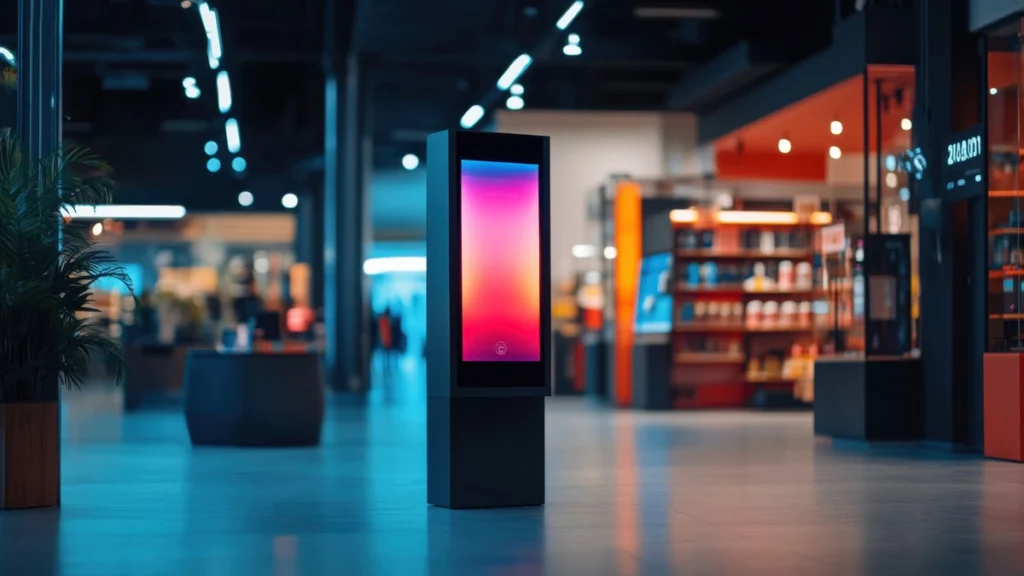Retail is undergoing a seismic shift, and digital signage is at the forefront of this transformation. As customer expectations evolve, businesses are leveraging advanced technologies to create more engaging, personalized, and seamless shopping experiences. Let’s explore how digital signage will reshape the retail landscape in 2025 and the trends driving this change.

1. Enhanced Customer Engagement
Digital signage offers a dynamic way to capture customer attention, moving beyond static posters and displays. Retailers are using high-resolution screens, video walls, and interactive touchscreens to create immersive in-store experiences.
Key Features:
- Dynamic Content: Vibrant visuals, animations, and real-time updates keep customers engaged.
- Interactive Displays: Touch-enabled screens allow customers to browse products, check inventory, and even place orders in-store.
- Storytelling Opportunities: Digital signage helps brands tell compelling stories, deepening customer connections.
Why It Matters: Engaging customers with visually appealing and interactive content enhances the overall shopping experience, encouraging longer dwell times and increased sales.
2. Personalized Advertising
In 2025, personalization will be the gold standard for retail, and digital signage will play a pivotal role. AI-powered systems are enabling retailers to deliver tailored messages based on customer preferences, behaviors, and demographics.
How It Works:
- AI and Machine Learning: Analyze customer data to serve relevant ads and promotions.
- Facial Recognition Technology: Identify customer age, gender, and mood to customize messaging in real-time.
- Geolocation and Proximity Marketing: Trigger personalized content when customers are near a specific store or product.
Why It Matters: Personalized advertising enhances customer satisfaction and boosts conversion rates by showing shoppers exactly what they need at the right moment.
3. Supporting the Omnichannel Experience
As omnichannel strategies become integral to retail, digital signage is bridging the gap between online and offline shopping. These displays seamlessly integrate with e-commerce platforms, mobile apps, and social media to create a unified customer journey.
Applications:
- Click-and-Collect Promotions: Inform customers about online order pickups or related offers.
- QR Codes and App Integration: Enable shoppers to scan codes for additional product details, reviews, or digital coupons.
- Social Media Displays: Showcase user-generated content, such as tagged posts and reviews, to encourage engagement.
Why It Matters: By aligning with omnichannel strategies, digital signage ensures a consistent and convenient experience across all touchpoints, driving customer loyalty.
4. AI-Powered Content Management
Artificial intelligence is revolutionizing how content is created and managed for digital signage. AI tools are enabling retailers to automate and optimize content delivery, ensuring relevance and timeliness.
Innovations to Watch:
- Predictive Analytics: Use historical data to predict customer trends and adjust content accordingly.
- Real-Time Adaptation: Automatically update signage based on factors like inventory levels, weather, or local events.
- Content Scheduling: AI systems determine the best times to display specific promotions for maximum impact.
Why It Matters: AI-driven content ensures that retailers deliver the right message at the right time, enhancing both efficiency and customer satisfaction.
5. Interactive and Experiential Displays
In 2025, digital signage will be more than just a display—it will be an experience. Retailers are using interactive and experiential technologies to immerse customers in their brand.
Examples:
- Augmented Reality (AR): Allow customers to visualize products, such as trying on clothes or seeing furniture in their homes.
- Gamification: Use interactive displays to engage customers with games and reward programs.
- Virtual Product Demos: Showcase how products work through touchscreens and 3D displays.
Why It Matters: Interactive signage not only entertains customers but also provides valuable information, making shopping more enjoyable and memorable.
Preparing for the Future of Digital Signage
To stay ahead, retailers should:
- Invest in Scalable Technology: Ensure digital signage systems can adapt to future advancements.
- Focus on Data Security: Protect customer data collected through AI and interactive displays.
- Collaborate with Experts: Partner with AV professionals to design and implement effective signage strategies.
Digital signage is set to transform the retail industry in 2025 by creating personalized, engaging, and seamless experiences. By embracing these trends, retailers can not only meet but exceed customer expectations, securing their place in the future of shopping.



